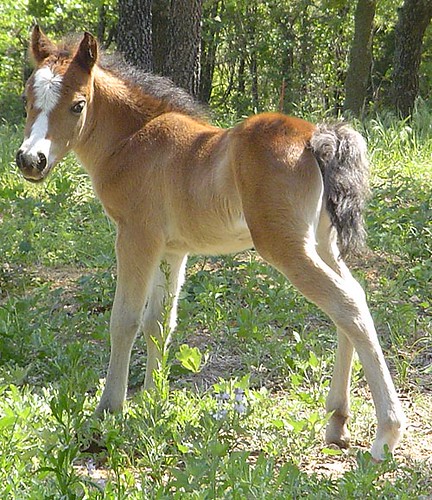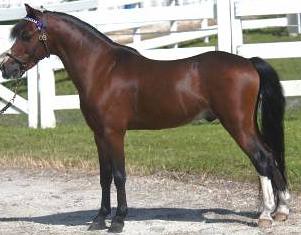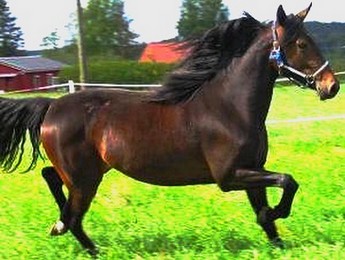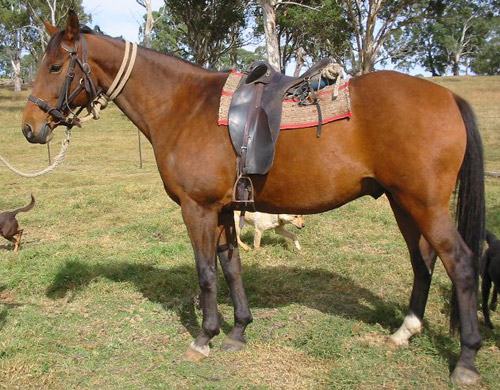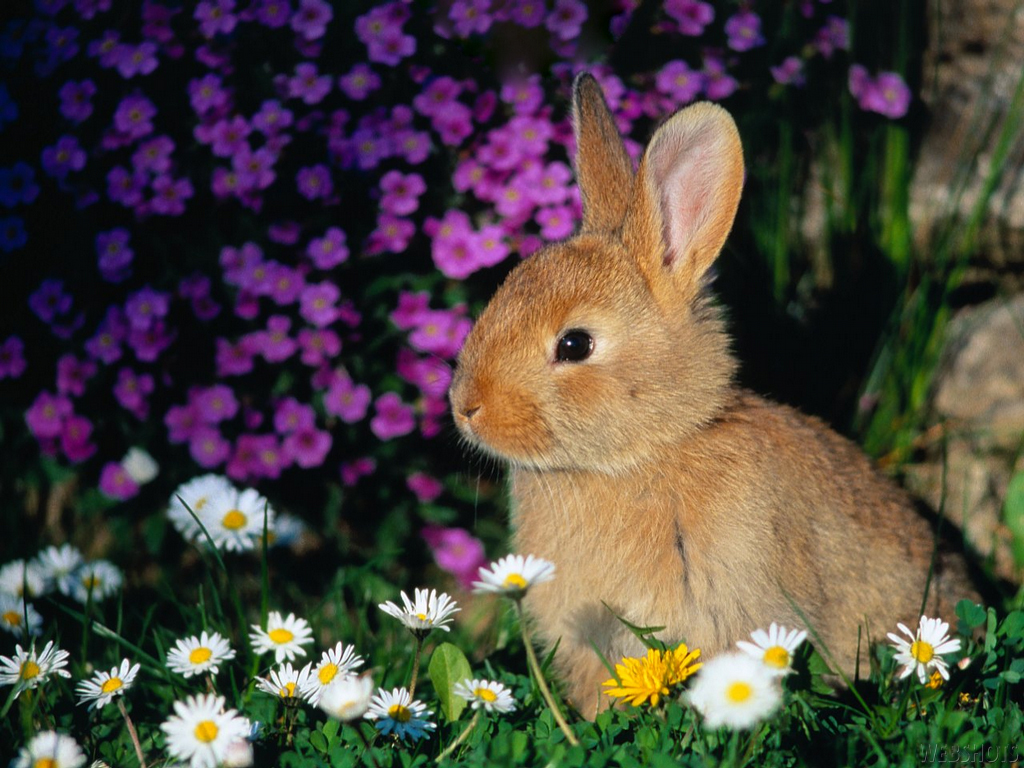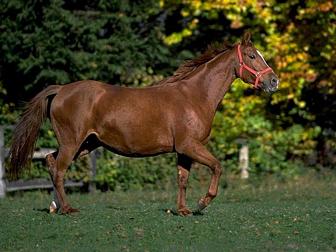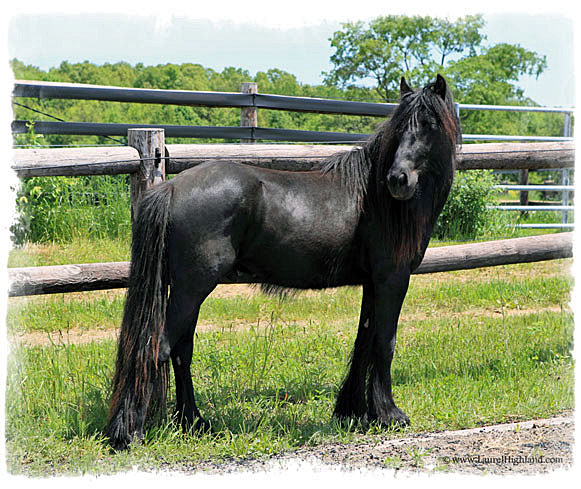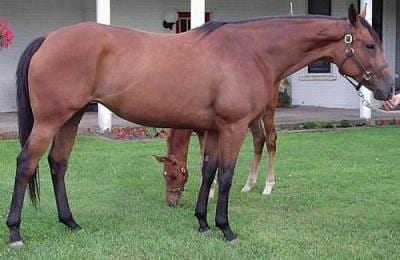Monday, April 30, 2012
American Shetland
Pony Of The Americas
The Pony Of The Americas is specifically bred to be a small horse rather than a true pony. It is quiet and docile and a excellent all rounder. It is tough and hardy, undemanding to care for, and easy for children to handle. The Pony Of The Americas is suitable as a general riding animal by children and can also be ridden by small adults. It is versatile enough to be used for a variety of jobs trekking, jumping, endurance riding, show jumping, trotting races, and even for pony flat racing. Developed to be a small horse rather than a true pony, the Pony Of The Americas is increasingly popular as a riding animal for children, teenagers, and smaller adults. Its high action and Appaloosa color patterns make it quite distinctive.
Sunday, April 29, 2012
Standardbred Horses
The Standardbred is the fastest trotting and pacing harness racer in the world. It has been bred with the most painstaking care and precision for one purpose only, to trot or pace harnessed to an ultralight two wheeled racing sulky for one mile (1.6km) to a minimum standard time. This aim has produced a definite breed of horse with predictable abilities and qualities of physique and temperament. The Standardbred, although undoubtedly a blood horse, is tough with great stamina, and although it requires reasonable care, it does not require excess cosseting. It is docile and easy to handle, willing, enthusiastic, and energetic with a natural competitive streak. The Standardbred's main role today is participating in trotting and pacing races, which take part in its homeland, the United States, but also in Scandinavia, Canada, Australia, and New Zealand. Those horses not used for racing, or which are just not fast enough, make excellent riding horses and seem particularly suited to endurance riding and hunting because of their stamina. Although they make good event horses, they are not quite as fast as the Thoroughbred, which still dominate the top levels of sport. Standardbred Horses stand about 14 to 16 hands high.
Posted by Joanna
Posted by Joanna
Saturday, April 28, 2012
Ukrainian Riding Horses
The Ukrainian Riding Horse is a mixture of excellent riding and competition breeds, most of which are bred for good temperament. The Ukrainian Riding Horse has picked up its trait, being kind natured, obliging, and a willing worker. It is a quality warmblood horse with strength, stamina, and scope. Principally a high class competition horse, the Ukrainian Riding Horse is used for general pleasure riding, light harness work such as
carriage driving, and also in agriculture, depending on individual type and build. Ukrainian Riding Horses stand about 16 hands high.
Posted by Joanna
carriage driving, and also in agriculture, depending on individual type and build. Ukrainian Riding Horses stand about 16 hands high.
Posted by Joanna
Friday, April 27, 2012
Australian Pony
The Australian Pony s an excellent riding pony, refined yet not too light. It is renowned for being sound and healthy, robust, responsive, even natured, and hardy. It shows its blood ancestry, but does not require cosseting, and it is easy for children to ride and care for. One of its most favored features, in addition to its excellent temperament, is its long, free, and flowing action. The Australian Pony is mainly used as a children's riding pony, but is also makes a good harness pony. It has good jumping ability and has the quality to be shown at the highest level. Its stamina also makes it popular for junior trail and endurance riding. The Australian pony is a mixture of pony blood from Europe and Indonesia, plus the Eastern influence of the Arab and Thoroughbred. It is popular as a children's riding, trail, and endurance pony, and it also goes well under harness. Australian ponies stand about 12 to 14 hands high.
Posted by Joanna
Posted by Joanna
Australian Stock Horse
The Australian Stock Horse has good temperament, courage, toughness, and stamina. The Australian Stock Horse is used for stock work, rodeos, and for general riding. It is also often used as a high quality competition horse. The Australian Stock Horse shows much Quarter Horse character but with obvious Thoroughbred influence. The breed has had a fairly checked history in its short lifetime, but is now established and popular in many spheres, being used for general riding, stock work, rodeos, and as a competition horse. Australian Stock Horses stand about 15 to 16 hands high.
Posted by Joanna
Posted by Joanna
Paso Fino Horses
The Paso Fino Horse is much in demand for leisure riding, showing, parade and display work. The Paso Fino Horse has an exceptionally gentle temperament. It is probably the best looking example of the existing Paso types, having an Arab type head and a Andalusian body. The horse is intelligent and easy to handle. Paso Fino horses stand about 14 to 15 hands high.
Posted by Joanna
Posted by Joanna
Thursday, April 26, 2012
Icelandic Ponies
The Icelandic Pony is unsurprisingly tough and hardy, requiring almost no special care. It is very strong and sound, quiet to handle, inquisitive, friendly, yet independent. Today, the ponies find a fairly ready market outside their homeland for they excel as children's ponies and are popular as trekking mounts. They are also outstanding as endurance rides. They are still used by farmers in Iceland for a variety of farming tasks. The Icelandic Pony is stocky and strongly built. The neck is short and thick, and the legs are short and sturdy, with short cannons and extremely tough feet. The Icelandic Pony is a five gaited pony. Its most distinctive gait is the tolt, a running walk as fast as a canter. Icelandic Ponies stand about 12 to 13 hands high.
Wednesday, April 25, 2012
Andalusian Horses
Pride, courage, and spirit combined with docility and affection toward people typify the Andalusian's character. Small children habitually ride them in Spain, yet they possess all the fire and presence demanded by an expert horseman of a display or parade horse. The Andalusian is mainly used for display purpose and for bullfighting. The agility and power of the breed ideally suit it to the intricate movements needed of a bullfighting horse, from which some Haute Ecole airs derive. It is difficult to import the best examples of a breed which is jealously guarded in its homeland, but the breed is gradually spreading and there are a limited number of Andalusians in Britain, more in the United States, Andalusians have the conformation and power to make good jumpers. They are athletic, energetic horses with ideal gaits for advanced dressage, but apart from being superb general riding and carriage horses, they are used in showing classes, both in hand and under saddle. Andalusian horses stand about 15 hands high.
Posted by Joanna and Becca
Posted by Joanna and Becca
Brabant Horses
The dominant characteristics of the Brabant are its docile temperament, its strength, and its weight. It has been described as phlegmatic, even sluggish, but almost always good natured. As for pulling power, it is almost impossible to beat, its nearest rival in strength being the English Shire. It is an early maturing and long lived horse, obedient, unflappable, extremely strong and reliable, willing to work hard. It has a strong constitution and is very hardy, requiring only moderate amounts of food considering its size and body mass. In common with all heavy breeds, the Brabant is used mainly for heavy agricultural and haulage work short haul road transportation, logging, estate work, and as a dray horse. It is enthusiastically received in the show ring, either in showing classes or in publicity displays. The Brabant is still used as a foundation stock in warmblood breeding. A major influence on most of the world's heavy breeds, the Brabant became even more popular than the old Flanders Horse in the development of heavy breeds in the 19th century. A powerful horse, with a willing temperament, its blood is still used in warmblood breeding. Brabant horses stand about 15 to 17 hands high.
Posted by Joanna and Becca
Posted by Joanna and Becca
Tuesday, April 24, 2012
Fjord Ponies
The Fjord is an ancient type of pony resembling Przewalski's Horse, which may well have been its ancestor. Its coloring and markings are primitive, and it is a true representative of the Celtic pony group. It has a kind willing nature, but some are said to be stubborn. It is very strong and tough, and has great stamina. The Fjord is a sure footed and fearless mountain pony. It is still used for plowing on rough terrain, but is more popular as a trekking pony. It also takes part in Fjord trotting races, long distance events, and competitive driving. Fjord ponies stand about 13 to 14 hands high.
Posted by Joanna and Becca
Posted by Joanna and Becca
Monday, April 23, 2012
Haflinger Ponies
Halfingers are docile yet bright, friendly, and trusting toward humans. They are late maturing but extremely hardy, and have great stamina and strength. The Halfinger is still used in forestry and farming in the Alps, and is equally at home in harness pulling sleighs, carts, or carriages, and under saddle. It is also a popular family pony. Of heavy type with an Arab look to the head the Halfinger is chunky and compact, possessing great strength and endurance. Founded hundreds of years ago as a small sturdy, working horse the modern Halfinger has survived border changes in its home region between Austria and Italy. It remains an extremely popular large working pony and is especially useful as a family pony, since it is noted for liking people.
Posted by Joanna and Rebecca
Posted by Joanna and Rebecca
Sunday, April 22, 2012
New Forest Ponies
Today's New Forest pony is a recognizable type of pony, and broken in ponies exhibit a friendly, calm temperament. The breed is noted for strength, nimble footedness, speed, and intelligence. The New Forest is mainly used for riding, although it goes well in harness. It is used for trekking and forest rides, and is an excellent Pony Club all rounder and family pony for hacking, hunting, or competing. New Forest ponies stand about 14 hands high.
Posted by Joanna and Rebecca
Posted by Joanna and Rebecca
Hackney Horses and Ponies
The Hackney Horse and Hackney Pony are spirited and energetic animals, not suited to novice handlers. They have great stamina at a fast trot and require expertise in their handling. These days, Hackneys are almost exclusively used in the show ring, where their speed and stamina is seldom displayed or tested. Some Hackneys have been used in competitive carriage driving and show jumping. Today's Hackney presents an over all picture of fire and speed. Its conformation suggests it is ideally suited to carriage work. The Hackney Horse, and the Hackney Pony, are show horses par excellence. A very specialized breed, they are a horseman's Horse and need skilled handling to control their extravagant trotting action and spirited temperament. Hackney Horses and ponies range from 12 to 15 hands high.
Posted by Joanna and Rebecca
Posted by Joanna and Rebecca
Saturday, April 21, 2012
Salerno horses
The Salerno is spirited and lively, but has a level, tractable nature. it requires careful handling, but is not normally difficult or unduly sensitive. The Salerno is almost exclusively used as a leisure and competition horse because of its excellent jumping ability. It is also being used as the foundation for Italy's new modern sports horse breed, the Italian Saddle Horse. The Salerno resembles a middle weight Thoroughbred horse. The legs are hard, but with stronger feet than found in many Thoroughbreds. The Salerno was established in its modern form by the middle of the 20th century. It was a favored mount of the Italian cavalry for the sports of cross country riding and show jumping. Salerno horses stand about 16 hands high.
Sorry the picture is not very good.
Sorry the picture is not very good.
Italian heavy Draft
The Italian Heavy Draft is a distinctive breed with a friendly, calm nature and lively but docile temperament, although some individuals are notably highly strung. It is a smallish energetic, and quite fast draft horse, fairly hardy and easy to care for. The Italians have never had much inclination to breed massive, phlegmatic horses, so even when they produced their own heavy draft type, they went for a smallish animal with a lively action and bright temperament. Italian Heavy Draft horses stand about 16 hands high.
Swiss Warmblood Horses
The Swiss Warmblood is a quality horse with free, supple gaits and a proven talent for dressage and show jumping. It has a docile, kind temperament and is a willing, cooperative worker. The Swiss Warmblood is used as a general all round riding horse, with the best and most talented individuals competing on equal terms with the best competition horses in the world. In light harness, the breed is elegant and stylish. Swiss Warmblood horses stand about 16 hands high.
Posted by Joanna.
Posted by Joanna.
Friday, April 20, 2012
Exmoor Ponies
Exmoors are tough and hardy, with a willing and hard working nature provided they are caught and broken in when young. The Exmoor is extensively used as a children's riding pony and for trekking. They are ideal for endurance riding due to their great stamina, and are also used in competitive driving trails. Exmoors are sturdy and thickest ponies, with full and wiry manes and tails. The legs are slender but strong with well formed joints. The feet are small but very hard and rounded.
Fell Pony
The Fell Pony is closely related to the Dales Pony, but is smaller and of purer blood. It comes from the western side of the Pennine hills, which run down the northern half of England. The Fell Pony is a true mountain and moorland pony, still bred and running free on the hills, although some are bred on farms and private studs. It is almost certainly descended from the Celtic Pony, and also contains Dutch Friesian blood introduced initially by the Romans. A now extinct breed to influence the Fell was the Scottish Galloway, a tough breed whose qualities
have been inherited in full by today's Fell Pony. The Fell Pony was used as an informal trotting race pony, for sheep herding and as a pack pony in the lead mining industry. The Fell Pony transported lead in panniers weighing up to 110lb(50kg) each. The ponies walked in single file herded by a single rider, covering up to 30 miles (48km) a day. The Fell Pony has a iron constitution, with great pony character and wild air. It has a friendly, willing, yet determined, nature. The Fell Pony is widely used in England's Lake District as a trekking pony for tourists. It makes an excellent children's pony and is also good in harness. A few farmers still use Fell Ponies for herding sheep. Fell Ponies stand about 14 hands high.
have been inherited in full by today's Fell Pony. The Fell Pony was used as an informal trotting race pony, for sheep herding and as a pack pony in the lead mining industry. The Fell Pony transported lead in panniers weighing up to 110lb(50kg) each. The ponies walked in single file herded by a single rider, covering up to 30 miles (48km) a day. The Fell Pony has a iron constitution, with great pony character and wild air. It has a friendly, willing, yet determined, nature. The Fell Pony is widely used in England's Lake District as a trekking pony for tourists. It makes an excellent children's pony and is also good in harness. A few farmers still use Fell Ponies for herding sheep. Fell Ponies stand about 14 hands high.
Thursday, April 19, 2012
French Trotter
The French Trotter is a horse of considerable quality with the appearance of a big and strong Thoroughbred. The harness trotters are slightly smaller than the ridden trotters. The temperament of the French Trotter is similar to that of the Thoroughbred with regard to both spirit and energy. The French Trotter today is used almost exclusively as a trotting racer in harness and under saddle. Horses which do not make the grade in racing do, however, make very good riding horses and seem to have an inborn jumping ability. The saddle bred trotters are used to stud to sire competition and general riding horses French trotter blood is found in the Selle Francais. French Trotter horses stand about 16 hand high.
Wednesday, April 18, 2012
Dartmoor pony
The Dartmoor is tough, strong and hardy with a quiet, sensible and kind nature. The Dartmoor is used today as an ideal children's riding pony and in competitive driving. The Dartmoor is an example of an indigenous breed which, although subject to infusions of other blood, has largely retained its original characteristics. It now makes an excellent children's and small harness pony. Although herds of purebreds live on the moor, mares are usually put in foal to purebred stallions on farms and private studs, where most ponies are bought in for the winter. Full of real pony character, the Dartmoor is sturdy and well balanced, with slender but sturdy legs and tough well formed feet. The Dartmoor's distinguishing feature is its blood horse like action. when moving it hardly shows any knee flexion, having a free, long, and low stride. Dartmoor ponies stand about 12 hands high.
Tuesday, April 17, 2012
Information about horses
A mare is in foal for little over 11 months. In nature foaling is geared to coincide with the growth of nutritious spring grasses. Most breeds have an official spring birth date. Some breeds, such as the Thoroughbred, have a mid winter birth date (January 1 in the northern hemisphere and August 1 in the southern hemisphere). Thoroughbreds have their reproductive year brought forward artificially in order to have foals born as soon after that date as possible. as a prey animal, a foal has to be able to keep up with the herd within a day. Most births take place at night to give the foal time to get to its feet, find its balance, and be able to run by day break. In the wild foal suckle their dams for about a year, or so. Grass gradually replaces milk as the main foodstuff in the first year. Domestic foals are usually weaned at about six months. A horse matures between five and seven years of age, depending on the breed and the individual. A foal matures roughly from the ground up. The feet bones and legs mature at about two to three years, and the spine is fully developed by five to seven years. A reasonable age for a horse to begin real training for work is three years, when the work should be kept very light, gradually increasing as the horse matures, and can be put into full work at six. A horse is considered to be in his prime between the age of 8 and 12 years old. After about 17 years of age, his capacity for work will gradually wane.
Old horses are prone, like old humans, to diseases of old age such as arthritis and rheumatism. An old horse may also become more sensitive to the weather and pests, and may slip down the herd hierarchy. Complete retirement may not always be the best option the horse may fell unwanted and bored, particularly if he has been stabled for much of his life. In some cases it may actually be kinder to put down a horse, rather than to send him to a miserable retirement.
Posted by Joanna
Old horses are prone, like old humans, to diseases of old age such as arthritis and rheumatism. An old horse may also become more sensitive to the weather and pests, and may slip down the herd hierarchy. Complete retirement may not always be the best option the horse may fell unwanted and bored, particularly if he has been stabled for much of his life. In some cases it may actually be kinder to put down a horse, rather than to send him to a miserable retirement.
Posted by Joanna
Sunday, April 15, 2012
Dales pony
A strong but not coarse animal, the Dales pony has played an important role in the history of England's economy their trotting ability made them particularly sought after as pack ponies able to carry heavy weights over very rough ground. Today their stamina and calm temperament make them ideal for trekking, and as driving ponies.Today, the Dales is coming into its own as a trekking and competition driving pony. Dales are tough and hardy, with particularly hard legs and feet, and are able to withstand harsh outdoor conditions. They are quiet, but show intelligence and personality. The Dales pony is the one native British breed which has never been truly wild. Although descended from the primitive Celtic pony, it has received infusions of other blood. The Dales pony hails from the Yorkshire hills and dales on the eastern side of the Pennine hills which run down the northern half of England. Dale ponies stand about 14 hands high.
More information about horses
A hand is 4in (10cm), the approximate width of a man's hand. Horses and ponies are measured from the highest point of the withers down to the ground in a perpendicular line. Measuring sticks are calibrated in hands and inches. The animal is stood on level ground with both forelegs together and the stick placed next to its shoulder with the arm touching the top of its wither. The measurement is read in hands and inches, for example, 15.2hh (hands high) means 15 hands and 2 inches. Horses are measured from the highest point of the withers. Exercise is extremely important for a horse's wellbeing . Horses are designed for life on the move. The natural lifestyle of a horse is almost constant walking, eating as it goes, and domestic horses should be allowed to mimic this as far as possible, even if they are stabled. Two hours exercise a day, mostly walking with some trotting and perhaps cantering, is the minimum required to keep most stabled horses healthy and happy. Horse communicate with each other, and with other animals and people, mainly by body language and facial expressions. They do, though, also use their voices. Anger, dislike, or threat toward a particular individual is shown be head outstretched, ears flat back, eyes angry, nostrils drawn back and wrinkled, and perhaps the teeth being bared ready to bite or warn. Interest is shown by ears pricked (pointed) toward the interesting object or person, the eyes alert, the head held high if the object is distant or more flexed inward if it is near, and nostrils open (flared)
and perhaps quivering if the horse is near enough to smell the object or person. Fear is shown by ears being directed toward whatever the horse is afraid of. The eyes will look wide and alarmed, the nostrils will be wide open, and the skin will appear tightly drawn across the face. A sign of submission in youngsters, is the head outstretched and held fairly low, with the front teeth being gently snapped repeatedly together. this is called mouthing. The attitude of flehmen is when a horse is closely examining an odor. it breathes in the smell, then raises its head and turns its upper lip up to hold the smell in its air passages where the sensory Jacobsen's organ analyzes the odor. Stallions herd their mares and offspring with a peculiar snaking motion. the head and neck are outstretched and held low as he goes along, usually at a trot, snaking his head and neck from side to side.
Posted by Joanna and Rebecca
and perhaps quivering if the horse is near enough to smell the object or person. Fear is shown by ears being directed toward whatever the horse is afraid of. The eyes will look wide and alarmed, the nostrils will be wide open, and the skin will appear tightly drawn across the face. A sign of submission in youngsters, is the head outstretched and held fairly low, with the front teeth being gently snapped repeatedly together. this is called mouthing. The attitude of flehmen is when a horse is closely examining an odor. it breathes in the smell, then raises its head and turns its upper lip up to hold the smell in its air passages where the sensory Jacobsen's organ analyzes the odor. Stallions herd their mares and offspring with a peculiar snaking motion. the head and neck are outstretched and held low as he goes along, usually at a trot, snaking his head and neck from side to side.
Posted by Joanna and Rebecca
Saturday, April 14, 2012
More information about horses
Using a lunge rein is a common way to break in of initially train horses in English type equitation. The trainer stands with the horse on a long (lunge) rein, and works the horse mainly in circles around him or her. At first the youngster is led with the trainer, and maybe an assistant, close to it, teaching it basic commands such as walk, trot, canter, and whoa for stop. Gradually, the trainer moves farther and farther away from the horse as it becomes used to the various commands. Lungeing, as it is called, teaches the horse to obey the voice and is a useful method of early training and fittening. It should not be overdone however, as working in circles can be very hard work, particularly for young animals. The horse's first line of defense against danger, usually a predator, is fight. They will run in a scattered bunch when frighted. They will normally only turn and fight when they have no escape route of must stand their ground such as when a mare defends her foal or a stallion his harem. When traveling from one grazing ground to another, they often go more or less in single file at a walk or canter. Feral horses don't seem to use the trot gait very often. Horses live in herds as a form of defense. A lone animal is much more vulnerable to predators. To calculate the age of a horse in human terms, one year is usually thought of as four horse years. However horses have a short adolescence, a long, active adulthood, and a short decline into old age. Domestic horses which are well cared for can live a long time. However, it is common for domesticated horses to be put down when they are no longer able to work or when they fall victim to diseases, usually between the age of 20 and 25. With good care and fair work, horses can live useful, contented lives well into their twenties and even beyond.
Albino
White horses have always been regarded by many as spectacular or glamorous, and American Albino also have the advantage of generally being bred for good conformation and temperament. White horses, rather like Palomino horses, have always been associated with glamour and show. In horses, the albino is really a type and not a breed, yet in the U.S. they are regarded as a breed, American Creams, the foundation stallion being Old King, foaled in 1906 and possibly of Morgan /Arab blood. The breed association is favoring stock of Quarter Horse. Morgan, Thoroughbred, or Arab type and various color combinations of white and cream body coat or mane tail hair, pink or cinnamon colored skin, and blue or dark eyes.
Wednesday, April 11, 2012
Swedish Warmblood horses
Swedish Warmbloods are tractable and intelligent. They have excellent jumping ability flowing, elastic gaits, and plenty of speed and stamina for horse trials. Mainly bred for competition purposes, those not quite up to standard are used as general riding and leisure horses. Formerly a superior cavalry horse, the Swedish Warmblood is today one of the most successful competition horses in the world. It is one of the few Warmbloods fast enough for eventing and is also an excellent competitive carriage driving horse. Swedish Warmblood horses stand about 17 to 16 hands high.
Posted by Joanna and Rebecca
Posted by Joanna and Rebecca
Subscribe to:
Posts (Atom)



